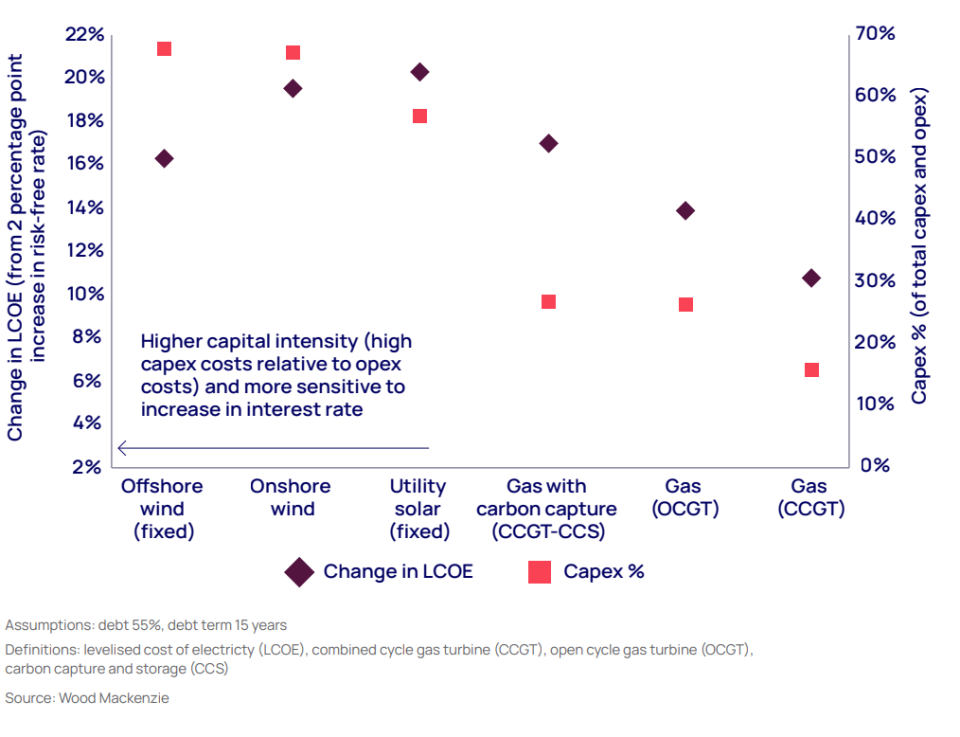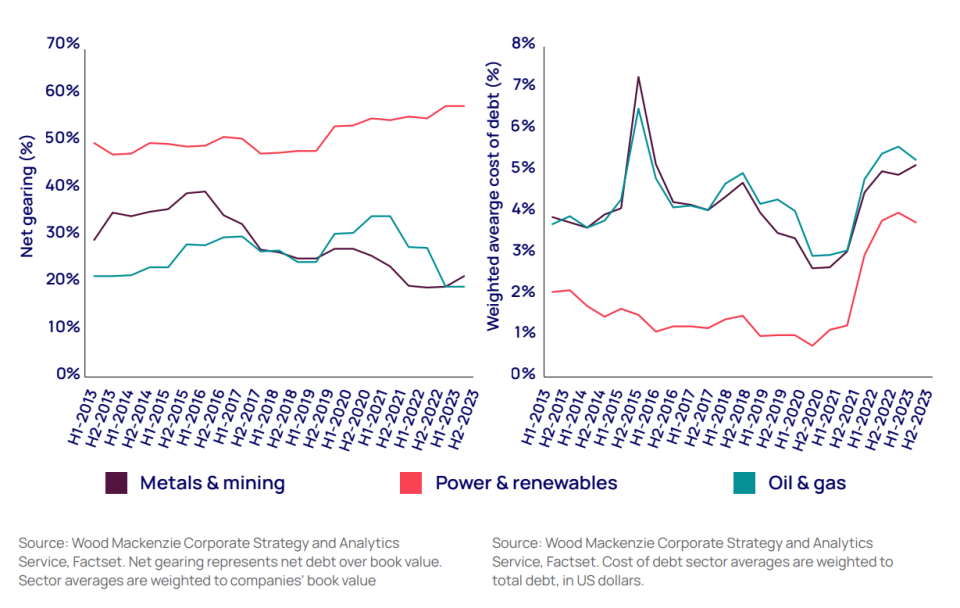

Figure 1


Figure 2




news release
Renewable energy and early low carbon technologies exposed to the highest interest rates
Policymakers should focus on strengthening carbon markets, maximizing subsidy efficiency and mobilizing green finance.
London, April 18, 2024 – If interest rates continue to remain high, the transition to a net-zero global economy will become more difficult and costly. The latest report, Conflicts of Interest: The Cost of Investment in the Energy Transition, shows that rising borrowing costs are more likely to affect renewable energy and This has had a negative impact on early technology. “The Age of High Interest Rates” by Wood Mackenzie.
“Interest rates, which have risen sharply over the past two years, may not come down as quickly or as much as the market expects. and the pace,” said Peter Martin, head of economics at Wood Mackenzie and lead author of the report.
Rising interest rates will have a disproportionate impact on renewable energy and nuclear power. High capital intensity and low returns put future projects at risk. In comparison, many companies in the metals, mining and oil and gas sectors are relatively less exposed to rising interest rates due to lower gearing, the report said.
In the US, Wood Mackenzie analysis shows that a 2 percentage point increase in risk-free interest rates would push up the levelized cost of electricity (LCOE) for renewables by as much as 20 percentage points. The relative increase in LCOE for a combined cycle gas turbine plant is only 11%.
Rising interest rates will also affect the competitiveness of renewable energy, the report said. In many markets, onshore wind and solar power are economically advantageous over hydrocarbon sources, sometimes even without subsidies. In the United States, onshore wind power can generate electricity for an LCOE of USD 40/MWh, which is 50% of the cost of gas-fired power generation. However, rising interest rates are eroding that advantage.
“Electricity and renewable energy companies have higher gearing but are better off compared to other peer groups on a cost of debt basis. But this is precisely why they are more sensitive to interest rates. Mechanisms to reduce risk by lowering interest rates will therefore allow power and renewable energy companies to acquire debt more cheaply than the relatively riskier oil, gas, metals and mining sectors. The increase has a proportionately larger impact on the cost of debt,” Martin said.
Green technology under pressure
Initial technologies such as low-carbon hydrogen, carbon capture, utilization and storage (CCUS) and direct air capture (DAC) will play a key role in the energy transition. However, with notable levels of capital investment and high capital intensity, these projects are under threat amid rising interest rates, the report said.
“The lack of economic incentives for carbon capture and the lack of a hydrogen market are the biggest obstacles to investment in these areas, but rising interest rates will have a negative impact on the economy if projects go ahead. This is a challenge for smaller developers who struggle to access debt and for large, credit-worthy developers who rely on low-interest leverage to make their projects attractive to shareholders. It affects both people and people,” Martin said.
How can policymakers offset interest rate headwinds?
The high interest rate environment is a headwind for the global energy transition, with it currently estimated that US$75 trillion of investment is required for the world to reach net zero by 2050.
“The good news is that there are actions policymakers can take now to offset or at least reduce the burden of rising interest rates. Policymakers can support the deployment of low-carbon energy and early green technologies. To do so, we need to remove barriers such as slow permitting and project approvals, and provide clear, consistent and sustainable incentives.”
In its report, Wood Mackenzie identified three policy priorities for policymakers:
-
Emphasize the efficiency of subsidies. With government finances under pressure, subsidies need to have the greatest impact on decarbonizing the global economy. Targeted and indiscriminate subsidies are the most efficient and minimize nationalistic subsidy fights that are counterproductive to global emissions targets.
-
Strengthen carbon markets. First and foremost, we conclude the outstanding parts of Article 6 of the Paris Agreement, the original “rulebook” for carbon markets and non-market approaches to reducing global emissions.
-
Mobilize climate finance. Greater use of financial mechanisms and instruments to maximize private sector investment is needed. Central banks may offer loans at preferential interest rates to commercial banks, particularly to finance low-carbon investments.
end
Editor's note:
About the report: “Conflict of interest: The cost of investing in the energy transition in an era of high interest rates.”
The era of zero interest rates is over. Rising borrowing costs will have an uneven impact on the energy and natural resources sectors. Low-carbon energy and nascent green technologies, which are highly capital-intensive and often dependent on subsidies, are most at risk. In contrast, the oil and gas industry and large metals and mining companies are in a relatively advantageous position. In a scenario where interest rates rise, achieving net zero will become even more difficult and costly. This report is a must-read for investors, businesses, and policymakers looking to offset interest rate headwinds. read more.
For more information, please contact us below.
Vivien Lebbon, T: +44 330 174 7486, E: Vivien.lebbon@woodmac.com
About Wood Mackenzie
Wood Mackenzie is a business that provides global insights into renewable energy, energy and natural resources. Driven by data. Empowered by people. Businesses and governments in the midst of an energy revolution need reliable and actionable insights to guide the transition to a sustainable future. That's why, backed by over 50 years of natural resources experience, we cover the entire supply chain with unparalleled breadth and depth. Today, our team of more than 2,000 experts operates in 30 locations around the world, empowering customers to make decisions through real-time analytics, consulting, events, and thought leadership. Together, we provide the insights you need to differentiate between risks and opportunities and make bold decisions when it matters most. For more information, please visit: woodmac.com.
attachment





